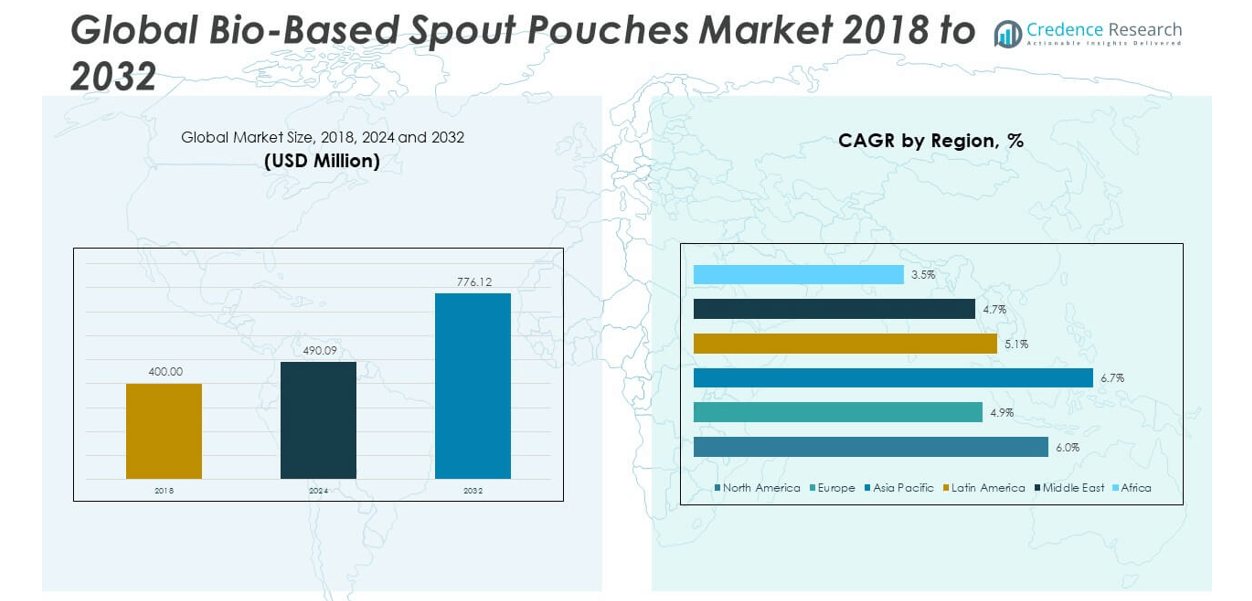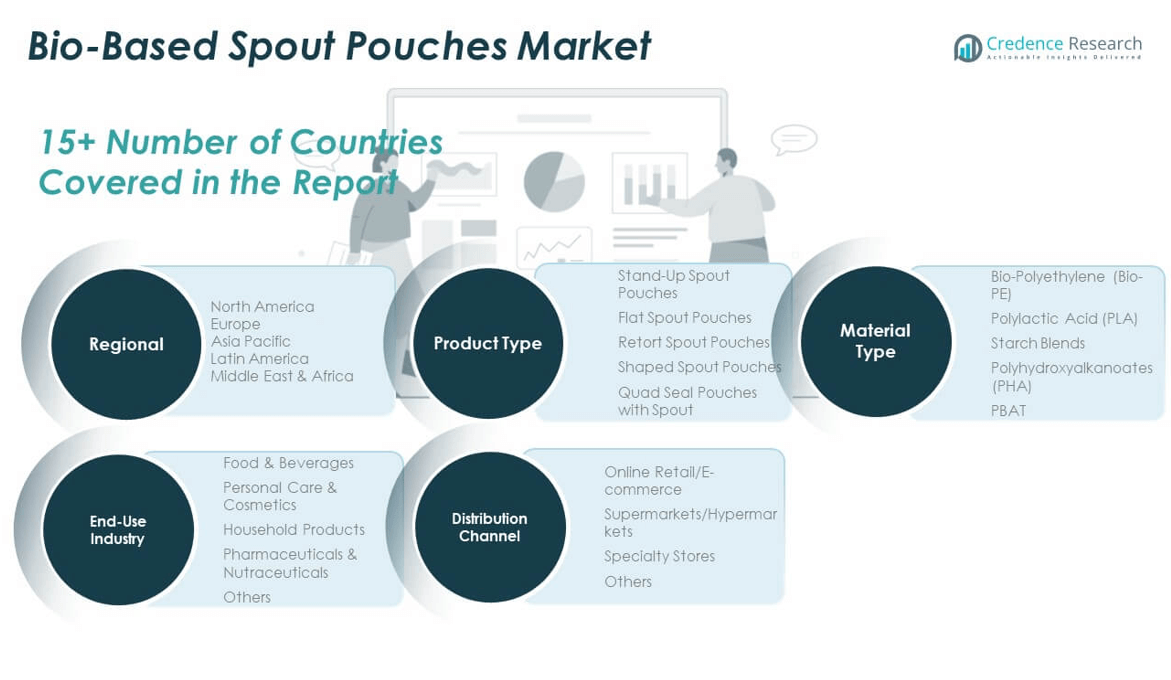CHAPTER NO. 1 : GENESIS OF THE MARKET
1.1 Market Prelude – Introduction & Scope
1.2 The Big Picture – Objectives & Vision
1.3 Strategic Edge – Unique Value Proposition
1.4 Stakeholder Compass – Key Beneficiaries
CHAPTER NO. 2 : EXECUTIVE LENS
2.1 Pulse of the Industry – Market Snapshot
2.2 Growth Arc – Revenue Projections (USD Million)
2.3. Premium Insights – Based on Primary Interviews
CHAPTER NO. 3 : BIO-BASED SPOUT POUCHES MARKET FORCES & INDUSTRY PULSE
3.1 Foundations of Change – Market Overview
3.2 Catalysts of Expansion – Key Market Drivers
3.2.1 Momentum Boosters – Growth Triggers
3.2.2 Innovation Fuel – Disruptive Technologies
3.3 Headwinds & Crosswinds – Market Restraints
3.3.1 Regulatory Tides – Compliance Challenges
3.3.2 Economic Frictions – Inflationary Pressures
3.4 Untapped Horizons – Growth Potential & Opportunities
3.5 Strategic Navigation – Industry Frameworks
3.5.1 Market Equilibrium – Porter’s Five Forces
3.5.2 Ecosystem Dynamics – Value Chain Analysis
3.5.3 Macro Forces – PESTEL Breakdown
3.6 Price Trend Analysis
3.6.1 Regional Price Trend
3.6.2 Price Trend by product
CHAPTER NO. 4 : KEY INVESTMENT EPICENTER
4.1 Regional Goldmines – High-Growth Geographies
4.2 Product Frontiers – Lucrative Product Categories
4.3 Material Type Sweet Spots – Emerging Demand Segments
CHAPTER NO. 5: REVENUE TRAJECTORY & WEALTH MAPPING
5.1 Momentum Metrics – Forecast & Growth Curves
5.2 Regional Revenue Footprint – Market Share Insights
5.3 Segmental Wealth Flow – Product Type & Material Type Revenue
CHAPTER NO. 6 : TRADE & COMMERCE ANALYSIS
6.1. Import Analysis by Region
6.1.1. Global Bio-Based Spout Pouches Market Import Revenue By Region
6.2. Export Analysis by Region
6.2.1. Global Bio-Based Spout Pouches Market Export Revenue By Region
CHAPTER NO. 7 : COMPETITION ANALYSIS
7.1. Company Market Share Analysis
7.1.1. Global Bio-Based Spout Pouches Market: Company Market Share
7.2. Global Bio-Based Spout Pouches Market Company Revenue Market Share
7.3. Strategic Developments
7.3.1. Acquisitions & Mergers
7.3.2. New Product Launch
7.3.3. Regional Expansion
7.4. Competitive Dashboard
7.5. Company Assessment Metrics, 2024
CHAPTER NO. 8 : BIO-BASED SPOUT POUCHES MARKET – BY PRODUCT TYPE SEGMENT ANALYSIS
8.1. Bio-Based Spout Pouches Market Overview by Product Type Segment
8.1.1. Bio-Based Spout Pouches Market Revenue Share By Product Type
8.2. Stand-Up Spout Pouches
8.3. Flat Spout Pouches
8.4. Retort Spout Pouches
8.5. Shaped Spout Pouches
8.6. Quad Seal Pouches with Spout
CHAPTER NO. 9 : BIO-BASED SPOUT POUCHES MARKET – BY MATERIAL TYPE SEGMENT ANALYSIS
9.1. Bio-Based Spout Pouches Market Overview by Material Type Segment
9.1.1. Bio-Based Spout Pouches Market Revenue Share By Material Type
9.2. Bio-Polyethylene (Bio-PE)
9.3. Polylactic Acid (PLA)
9.4. Starch Blends
9.5. Polyhydroxyalkanoates (PHA)
9.6. PBAT
CHAPTER NO. 10 : BIO-BASED SPOUT POUCHES MARKET – BY END-USER INDUSTRY SEGMENT ANALYSIS
10.1. Bio-Based Spout Pouches Market Overview by End-user Industry Segment
10.1.1. Bio-Based Spout Pouches Market Revenue Share By End-user Industry
10.2. Food & Beverages
10.3. Personal Care & Cosmetics
10.4. Household Products
10.5. Pharmaceuticals & Nutraceuticals
10.6. Others
CHAPTER NO. 11 : BIO-BASED SPOUT POUCHES MARKET – BY DISTRIBUTION CHANNEL SEGMENT ANALYSIS
11.1. Bio-Based Spout Pouches Market Overview by Distribution Channel Segment
11.1.1. Bio-Based Spout Pouches Market Revenue Share By Distribution Channel
11.2. Online Retail/E-commerce
11.3. Supermarkets/Hypermarkets
11.4. Specialty Stores
11.5. Others
CHAPTER NO. 12 : BIO-BASED SPOUT POUCHES MARKET – REGIONAL ANALYSIS
12.1. Bio-Based Spout Pouches Market Overview by Region Segment
12.1.1. Global Bio-Based Spout Pouches Market Revenue Share By Region
12.1.2. Regions
12.1.3. Global Bio-Based Spout Pouches Market Revenue By Region
12.1.4. Product Type
12.1.5. Global Bio-Based Spout Pouches Market Revenue By Product Type
12.1.6. Material Type
12.1.7. Global Bio-Based Spout Pouches Market Revenue By Material Type
12.1.8. End-user Industry
12.1.9. Global Bio-Based Spout Pouches Market Revenue By End-user Industry
12.1.10. Distribution Channel
12.1.11. Global Bio-Based Spout Pouches Market Revenue By Distribution Channel
CHAPTER NO. 13 : NORTH AMERICA BIO-BASED SPOUT POUCHES MARKET – COUNTRY ANALYSIS
13.1. North America Bio-Based Spout Pouches Market Overview by Country Segment
13.1.1. North America Bio-Based Spout Pouches Market Revenue Share By Region
13.2. North America
13.2.1. North America Bio-Based Spout Pouches Market Revenue By Country
13.2.2. Product Type
13.2.3. North America Bio-Based Spout Pouches Market Revenue By Product Type
13.2.4. Material Type
13.2.5. North America Bio-Based Spout Pouches Market Revenue By Material Type
13.2.6. End-user Industry
13.2.7. North America Bio-Based Spout Pouches Market Revenue By End-user Industry
13.2.8. Distribution Channel
13.2.9. North America Bio-Based Spout Pouches Market Revenue By Distribution Channel
13.3. U.S.
13.4. Canada
13.5. Mexico
CHAPTER NO. 14 : EUROPE BIO-BASED SPOUT POUCHES MARKET – COUNTRY ANALYSIS
14.1. Europe Bio-Based Spout Pouches Market Overview by Country Segment
14.1.1. Europe Bio-Based Spout Pouches Market Revenue Share By Region
14.2. Europe
14.2.1. Europe Bio-Based Spout Pouches Market Revenue By Country
14.2.2. Product Type
14.2.3. Europe Bio-Based Spout Pouches Market Revenue By Product Type
14.2.4. Material Type
14.2.5. Europe Bio-Based Spout Pouches Market Revenue By Material Type
14.2.6. End-user Industry
14.2.7. Europe Bio-Based Spout Pouches Market Revenue By End-user Industry
14.2.8. Distribution Channel
14.2.9. Europe Bio-Based Spout Pouches Market Revenue By Distribution Channel
14.3. UK
14.4. France
14.5. Germany
14.6. Italy
14.7. Spain
14.8. Russia
14.9. Rest of Europe
CHAPTER NO. 15 : ASIA PACIFIC BIO-BASED SPOUT POUCHES MARKET – COUNTRY ANALYSIS
15.1. Asia Pacific Bio-Based Spout Pouches Market Overview by Country Segment
15.1.1. Asia Pacific Bio-Based Spout Pouches Market Revenue Share By Region
15.2. Asia Pacific
15.2.1. Asia Pacific Bio-Based Spout Pouches Market Revenue By Country
15.2.2. Product Type
15.2.3. Asia Pacific Bio-Based Spout Pouches Market Revenue By Product Type
15.2.4. Material Type
15.2.5. Asia Pacific Bio-Based Spout Pouches Market Revenue By Material Type
15.2.6. End-user Industry
15.2.7. Asia Pacific Bio-Based Spout Pouches Market Revenue By End-user Industry
15.2.8. Distribution Channel
15.2.9. Asia Pacific Bio-Based Spout Pouches Market Revenue By Distribution Channel
15.3. China
15.4. Japan
15.5. South Korea
15.6. India
15.7. Australia
15.8. Southeast Asia
15.9. Rest of Asia Pacific
CHAPTER NO. 16 : LATIN AMERICA BIO-BASED SPOUT POUCHES MARKET – COUNTRY ANALYSIS
16.1. Latin America Bio-Based Spout Pouches Market Overview by Country Segment
16.1.1. Latin America Bio-Based Spout Pouches Market Revenue Share By Region
16.2. Latin America
16.2.1. Latin America Bio-Based Spout Pouches Market Revenue By Country
16.2.2. Product Type
16.2.3. Latin America Bio-Based Spout Pouches Market Revenue By Product Type
16.2.4. Material Type
16.2.5. Latin America Bio-Based Spout Pouches Market Revenue By Material Type
16.2.6. End-user Industry
16.2.7. Latin America Bio-Based Spout Pouches Market Revenue By End-user Industry
16.2.8. Distribution Channel
16.2.9. Latin America Bio-Based Spout Pouches Market Revenue By Distribution Channel
16.3. Brazil
16.4. Argentina
16.5. Rest of Latin America
CHAPTER NO. 17 : MIDDLE EAST BIO-BASED SPOUT POUCHES MARKET – COUNTRY ANALYSIS
17.1. Middle East Bio-Based Spout Pouches Market Overview by Country Segment
17.1.1. Middle East Bio-Based Spout Pouches Market Revenue Share By Region
17.2. Middle East
17.2.1. Middle East Bio-Based Spout Pouches Market Revenue By Country
17.2.2. Product Type
17.2.3. Middle East Bio-Based Spout Pouches Market Revenue By Product Type
17.2.4. Material Type
17.2.5. Middle East Bio-Based Spout Pouches Market Revenue By Material Type
17.2.6. End-user Industry
17.2.7. Middle East Bio-Based Spout Pouches Market Revenue By End-user Industry
17.2.8. Distribution Channel
17.2.9. Middle East Bio-Based Spout Pouches Market Revenue By Distribution Channel
17.3. GCC Countries
17.4. Israel
17.5. Turkey
17.6. Rest of Middle East
CHAPTER NO. 18 : AFRICA BIO-BASED SPOUT POUCHES MARKET – COUNTRY ANALYSIS
18.1. Africa Bio-Based Spout Pouches Market Overview by Country Segment
18.1.1. Africa Bio-Based Spout Pouches Market Revenue Share By Region
18.2. Africa
18.2.1. Africa Bio-Based Spout Pouches Market Revenue By Country
18.2.2. Product Type
18.2.3. Africa Bio-Based Spout Pouches Market Revenue By Product Type
18.2.4. Material Type
18.2.5. Africa Bio-Based Spout Pouches Market Revenue By Material Type
18.2.6. End-user Industry
18.2.7. Africa Bio-Based Spout Pouches Market Revenue By End-user Industry
18.2.8. Distribution Channel
18.2.9. Africa Bio-Based Spout Pouches Market Revenue By Distribution Channel
18.3. South Africa
18.4. Egypt
18.5. Rest of Africa
CHAPTER NO. 19 : COMPANY PROFILES
19.1. Amcor Plc
19.1.1. Company Overview
19.1.2. Product Portfolio
19.1.3. Financial Overview
19.1.4. Recent Developments
19.1.5. Growth Strategy
19.1.6. SWOT Analysis
19.2. Berry Global Inc.
19.3. Mondi Group
19.4. Smurfit Kappa Group
19.5. ProAmpac LLC
19.6. Glenroy, Inc.
19.7. Sonoco Products Company
19.8. Huhtamaki Oyj
19.9. SIG Group AG (via Scholle IPN)
19.10. Constantia Flexibles Group
19.11. Coveris Holdings S.A.
19.12. Winpak Ltd.
19.13. Guala Pack S.p.A.
19.14. Clifton Packaging Group Ltd.
19.15. Printpack, Inc.









